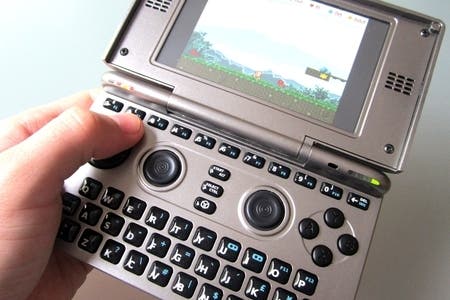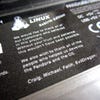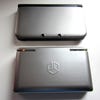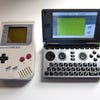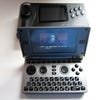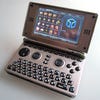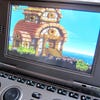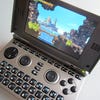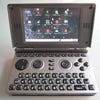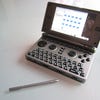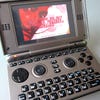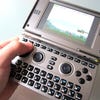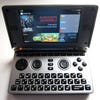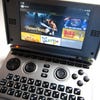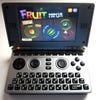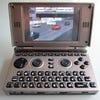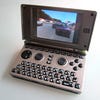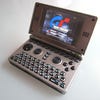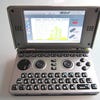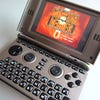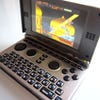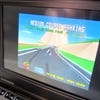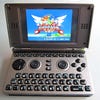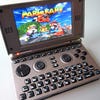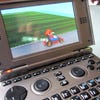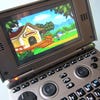The ultimate open source handheld: the return of Pandora
The astonishing story behind the world's first crowd-funded console, plus full review of the new 1GHz edition.
The world of open source handhelds is a strange but exciting place, dominated not by overbearing and cash-hungry manufacturers and publishers, but by the same breed of indie coders who are slowly but surely infiltrating the likes of XBLA, iOS, Android and Steam. Since the first truly 'open' consoles started to appear in the Far East at the dawn of the millennium, we've seen a long line of systems created with the ideals of freedom and experimentation very much at their core. These are platforms on which rules are made to be broken, and the only limitation is how far savvy and resourceful developers can push the host hardware.
One of the most notable examples is the Pandora, a joint venture between an international cadre of open source enthusiasts which was ultimately born out of frustration with the existing crop of portable options.
"I'd been sketching ideas like the Pandora for years," recalls Craig Rothwell, founder member of the Pandora team and one of the driving forces behind the open source gaming hardware scene here in the UK.
"When I was younger I tried to hack the Amstrad e-m@iler, as I wanted a truly portable computer."
Rothwell's interest in modding and hacking would result in him becoming actively involved with both the UK distribution of the GamePark GP32, regarded by many as the grandfather of the current open source gaming scene.
The GP32 was followed by the equally famous GP2X, which offered more power and functionality. The modest success of these products convinced Rothwell - who would later be joined by German tech enthusiast Michael Mrozek - that there was enough consumer interest to justify a totally new product.
"We've always been fans of 'open' devices - especially as more and more systems are becoming locked down," explains Mrozek.
"We wanted a gaming device where the user can install anything they want without the need for any hacking or jailbreaking."
However, Rothwell had no desire to imitate existing hardware.
"We knew it had to be slightly different from anything else on the market," he says.
"We could also see things like the PSP taking away share from the GP32 and GP2X, so we knew whatever we made had to be very different, yet offer similar expanded functionality. Making the Pandora a 'micro laptop' with gaming controls seemed to be a good move."
At first, Rothwell and his team decided to pitch their vision to GamePark Holdings, the now-defunct Korean firm responsible for the aforementioned GP2X.
"We actually went over there to try to convince them that they should join us in the venture, but they weren't interested," he explains, and the fateful decision was therefore made to go it alone, a choice which - initially at least - seemed to be a blessed one.
Rothwell and Mrozek went public with the concept, quickly garnering support from members of the burgeoning open source community, with many individuals stepping up to assume key positions within the team.
"We needed designers for the Printed Circuit Board (PCB) and the case," explains Mrozek.
"Luckily, Michael Weston in the US showed us some of the handhelds he had personally created, and he became the designer of the Pandora. The case designer also came from the community; he created some mods for the GP2X which drastically improved the system's gaming controls. After that, both the PCB and case were designed with features based on input from the community. This was a delicate process; the case had to be small and ergonomic to use, but the PCB also had to fit in properly."
It's the kind of operation that a large company like Sony or Nintendo would literally pour millions of dollars of research and development into, yet the Pandora team did it on a shoestring using the expertise of people who were, at best, amateur enthusiasts.
Best Laid Plans
With a core team established and the design in place, the next step was to acquire funding to actually manufacture the Pandora. This is where the story begins to take on a somewhat chaotic tone.
"We essentially did Kickstarter before Kickstarter even existed... we opened preorders and raised about $1 million in 24 hours, which predictably caused the bank to panic."
"We essentially did Kickstarter before Kickstarter even existed," Rothwell says.
"The plan was to take pre-orders and use the money to fund production. In the UK we had our bank on board and told them the plan, and they seemed to like the idea. However, looking back I really don't think they expected us to succeed. We opened preorders and raised about $1 million in 24 hours, which predictably caused the bank to panic. At first they moved $100,000 in to a 'reserve account' and then a week later totally dropped us, believing it was some kind of fraudulent operation.
"They refunded all customer orders and told us to clear off - we never got a proper explanation about why they did this. So we then had the nightmare task of trying to calm down customers who wondered what the hell was going on, and then to try to convince them to reorder via a bank transfer, as the bank had cancelled our merchant numbers meaning we couldn't accept credit cards for months. Slowly they did come back to us, but it was a lengthy and horrible period. Of course, these days sites like Kickstarter solve this; it's a great resource which I wish had existed back then."
Regaining the battered trust of your consumer base is one challenge, but when you're building unproven hardware from scratch without the assistance of an R&D budget numbering in the millions, the path to market is seldom a smooth one.
"Everything that could go wrong did go wrong," laments Rothwell.
"When you're making a device which is unique and has never been attempted before, you have to think on your feet and be ready for huge disasters. When we started only a handful of companies in the world could handle Package on Package (PoP) work - an essential part of the design and one of the key reasons why we could make the Pandora so small - and only one company was willing to consider our project. Unfortunately, they seemed to under-quote us and experienced difficulty meeting our order."
Despite these setbacks, production lumbered on.
"Everything was ready at the end of 2010," says Mrozek.
"So in February 2011, every Pandora should have been delivered and we should have had them in stock from then on. The company we were using to make the PCBs told us they needed eight months to produce 3000 boards - they'd previously promised us 1000 boards per week. When they arrived, 1000 didn't even work, which was equal to a cash loss of over 300,000 Euros. Considering the resultant sales we lost, the actual damage probably went into the millions."
"When you're making a device which is unique and has never been attempted before, you have to think on your feet and be ready for huge disasters... only one company was willing to consider our project."
Another problem involved the console's analogue slider 'nubs'.
"The first company who designed the nubs went bust just after receiving our payment of about 30,000 Euros." adds Mrozek, the end result being more delays, and having been told several times that the console would be ready soon, customers predictably began to get restless.
"This was where Michael really came into his own," admits Rothwell.
"He is an expert in writing long, calming posts when I'm tearing my hair out at the catastrophe that has befallen us. Generally, if people want a refund, we quickly let them have one. Fortunately, most people realised what a stressful and difficult job we had taken on - and that we were committed to the end - so they stayed on board."
Keen to see the Pandora dream through to completion, the vast majority of customers continued to support the venture.
"Luckily, only a few actually turned hostile," admits Mzorek.
"It's the unique design of the Pandora which makes it sell. The keyboard, the gaming controls and the vital fact that it's open source...we won't cripple your machine just because you torrented a film or played on an emulator."
"It was totally understandable, but still sad to see, as we did our best to provide the units but simply ran into issues. We always were open and honest to the community, so on the whole they understood and supported us. It's really the best community we could have wished for."
Better Late Than Never: The Pandora Today
It's fair to say that the Pandora project has been through an awful lot of ups and downs since it was unveiled back in 2008. To date, around 6000 have been sold - an insignificant amount by Nintendo and Sony's standards, but a considerable achievement for a team which at one point was working around the clock to assemble units by hand in a village hall in the North East of England. Given the hardships the team has had to endure, it's simply too tempting to ask what they would have done differently with the benefit of hindsight.
"It's hard to know where to start," Rothwell replies with an exasperated smile.
"If we had known how hard it would be to raise funds I think we would have set that up differently - maybe spreading the load over several banks, each taking a small amount to keep them from panicking. It would also have been good to have a legal team to oversee contracts and chase manufacturers, but such protection requires huge amounts of money, and we just didn't have that."
The Pandora team are now busy working on other projects, one of which is an updated Pandora console with a Texas Instruments DM3730 1GHz CPU - a step up from the 600MHz version seen in the original model.
"It can be twice as fast in some situations, especially with 3D games," explains Rothwell.
"Emulation flies like never before - it's easily the best handheld system in the world for emulation now, from Amiga to PSX, MAME to Pentium-level PC games. It even runs Android."
However, even with more powerful internal architecture, the Pandora is effectively a design that is almost half a decade old now. Can it possibly hope to remain relevant in a market which boasts such powerful portables as the PS Vita when the 1GHz model retails for more than twice the price? And what about the increasingly versatile selection of Android-powered devices, which will shortly include the Archos Game Pad?
"It's the unique design of the Pandora which makes it sell," counters Rothwell.
"The keyboard, the gaming controls and the vital fact that it's open source...we won't do a firmware update and cripple your machine just because you torrented a film or played on an emulator."
"The Pandora is a unique mixture of a lot of products, so instead of having multiple devices in your pocket, you can have just one. No smartphone or major gaming device will ever offer that much flexibility."
Mrozek is equally forthright in his praise for the machine.
"The passage of time makes selling the system harder, but the Pandora is still pretty innovative," he asserts.
"The PS Vita is a gaming device. Even if it is hacked, it would still be missing a keyboard and a full Linux OS - and the next firmware update would close it down again, so you'd have the constant fight between Sony and the hackers. As for smartphones, they lack the combination of gaming controls and a physical keyboard. True, there's the Xperia Play and other smartphones with a keyboard, but there's nothing on the market that combines both. Battery life is also often not as good on smartphones - you can play or work over 10 hours with a Pandora, or listen to music for about 60 hours. With our system, you've got access to a wide range of emulators, all with proper controls and keyboard support.
"Beyond gaming, you can edit documents with LibreOffice, do server administration with SSH, code and compile directly on the system, run homebrew applications, browse the web, watch videos and listen to MP3s. If you like, you can run Android and use compatible apps and games on that as well. The Pandora is a unique mixture of a lot of products, so instead of having multiple devices in your pocket, you can have just one. No smartphone or major gaming device will ever offer that much flexibility."
Having said that, the Pandora team is acutely aware that all the uniqueness in the world can't stop the irresistible advancement of technology, and that means the Pandora will need to be replaced by something more potent eventually. That's why Rothwell and Mrozek are already thinking about the next iteration of their hardware, but this time around, actually getting the thing funded should prove to be less akin to pulling teeth.
"The Pandora 2, if it happens, will be funded through Kickstarter," confirms Rothwell.
"We're already using the service for one of our other projects, the iControlpad2. If that turns out to be a success then we will use those very same controls on the Pandora 2. We plan to cut absolutely no corners - the next Pandora will be the most powerful handheld ever created - and it will still have that real world 10 hour battery life."
The Digital Foundry Verdict: A Box Worth Opening, But At What Cost?
All this chatter of tantalizing future endeavours makes it easy to forget that the existing Pandora is still a highly attractive piece of kit. The freshly upgraded 1GHz version comes with a new silver external case and benefits from updated firmware which grants the system even more power. We've been granted exclusive access to this enhanced version, and our findings are the basis for this review.
Roughly the same size as your 3DS but slightly heavier due to that meaty 4000mAh battery, the Pandora looks like a laptop that's been shrunk in the wash. The interface is extensive for a machine of such diminutive dimensions; not only do you get a gloriously comfortable 'rolling' d-pad - which puts to shame pretty much every other digital controller we've touched since the days of the Sega Saturn - but also dual analogue sliders and a 43-button QWERTY keyboard. Four fascia buttons and two shoulder triggers - along with three 'function' buttons located in-between the sliders - complete the arrangement. Rothwell and his team expended a considerable amount of time getting this element of the system absolutely spot-on, and it has paid off handsomely.
"Roughly the same size as your 3DS but slightly heavier due to that meaty 4000mAh battery, the Pandora looks rather like a laptop that's been shrunk in the wash."
Based on Ångström - a distribution version of Linux - the Pandora is capable of running a full desktop environment from start-up, but the scaled-down MiniMenu UI is highly recommended. This grid-based system keeps things simple and allows you to launch most apps and games with the bare minimum of effort, while dropping back to the full-feature desktop view is as easy as selecting an icon. Beyond that, the Pandora is - as Rothwell originally intended - a miniature PC; you can send email, browse the web and even write code. A single USB port on the rear allows you to incorporate a wide range of peripherals and TV-out capability means you can upscale the experience to a big screen when you're not out and about.
Twin SD card slots - each able to accept cards of up 128GB in size - grant the potential for a whopping 256GB of storage for downloads and other data. An online repository of compatible software is also available, which keeps tabs on newer versions of already-installed programs and allows you to update them painlessly over a Wi-Fi connection. When it comes to software support, the Pandora presents a typical snapshot of homebrew development. Crude games from bedroom coders rub shoulders with officially-sanctioned ports and newer titles, such as the excellent 2D platform adventure Frogatto (also available on iOS). However, it's in the field of emulation that the Pandora really excels.
This system is a powerhouse when it comes to replicating the performance of vintage hardware. 16-bit systems like the Mega Drive and SNES enjoy perfect emulation on the console, with the former even featuring support for Mega CD and 32X games. 32-bit Sony PlayStation emulation is also pleasantly robust, with titles like Gran Turismo and Castlevania: Symphony of the Night running almost flawlessly. N64 emulation is slightly less assured, with sound issues and some graphical problems on many games, but the emulators are in a continual state of development.
Of course, to fully appreciate these programs you have to suffer an inconsistent and often confused interface; each emulator is coded almost in isolation, with different developers incorporating their own unique UI language and button commands. It's often jarring to move from one program to the next, and many of them are simply quick and easy ports from the original PC source code - which means they lack proper menus and often drop straight back to the Pandora desktop when you exit a game. Thankfully, this is becoming less of an issue as coders start to optimise their emulators for the Pandora, adding in proper front-ends and vastly improved UI systems.
Another massive issue here is one of legality; despite the protestations of retro gamers that emulation is merely one way of keeping the past alive, the practice of downloading ROMs from dubious sites on the internet still attracts much negativity from many members of the industry - and rightly so, when you consider that many publishers are making a genuine effort to ensure that their past classics remain commercially available. When you purchase a system like the Pandora, you naturally need to be 100 per cent certain where you stand on this issue, because without emulation, the console undoubtedly loses a vital part of its intrinsic appeal.
"Another impressive aspect of the Pandora lies in its ability to mimic fellow Linux-based platforms. Android 2.3 has been ported to the system by industrious developers, and offers excellent levels of performance."
Another impressive aspect of the Pandora lies in its ability to mimic fellow Linux-based platforms - with Android being the most notable. Version 2.3 - also known as Gingerbread - has been ported to the system by industrious developers, and offers excellent levels of performance. There are a few incompatibilities as a result of the Pandora's lack of multi-touch support thanks to its resistive touch-screen, but on the whole it's a mighty impressive party trick. Games like Grand Theft Auto 3 and Fruit Ninja run particularly well, thanks to the machine's PowerVR SGX530 200MHz GPU.
Despite its striking features and almost unmatched degree of functionality, the Pandora's biggest stumbling block remains its price. Creating a device like this at a grassroots level isn't cheap; the Pandora team can't rely on mass production to scale down their costs, and the experience and expertise showcased by larger, more established manufacturers simply isn't there to be called upon. Consequently, the system is still expensive, starting at 280 Euros (approximately £220) for the 'classic' 600MHz model with 256MB of RAM and going all the way up to an eye-watering 660 Euros (£530) for the newer 1GHz edition, equipped with 512MB of RAM. Clearly, this isn't a device aimed at the mass-market consumer who would ordinarily pick up a 3DS or Vita; it's targeted squarely at the homebrew and open source enthusiast.
For half a grand you could argue that you're getting an awful lot for your money with the 1GHz Pandora; for coders, it's a capable mobile PC with near-limitless customisation and software expandability, and for lovers of classic gaming it represents the ultimate emulation platform. Whether or not you can personally justify that steep price-point is something you'll have to discuss with your bank balance, but nevertheless, it's heart-warming to live in a world where projects like the Pandora can overcome adversity and eventually come to fruition.
